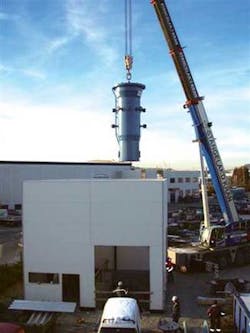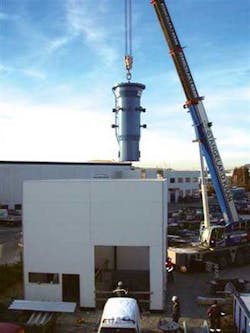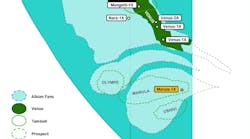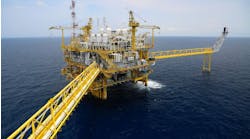Frank Hartley • Houston
Going further afield
The offshore oil and gas industry faces significant challenges as it seeks to sustain and increase current production rates, and to make technically recoverable oil and gas (currently 5 to 10 tboe ) economically recoverable as well.
“With the tripling of global energy consumption over the past 50 years, accelerating decline rates, the increasing maturity of some of the world’s largest fields, and growing reservoir complexity, the E&P operator has to search further afield to tap into new oil and gas resources - often in the most inhospitable of conditions” says Svein Helge Pettersen, production manager, Roxar AS.
Today’s production challenges range from deepwater oil and gas production in the Gulf of Mexico and offshore West Africa to the extreme cold of Kazakhstan and sometimes hostile conditions in Alaska.
Entering deep waters
With shallow water production in decline, many new discoveries are in deepwater.
Pettersen says the 2006 World Deepwater Market Forecast estimates that annual expenditures on deepwater operations will reach more than $20 billion by 2010. According to the report, deepwater oil and gas output is expected to grow strongly, with deepwater oil production rising from 3 MMb/d in 2005 to more than 6.7 MMb/d in 2010 and gas production from 2.12 tcf/d in 2005 to 3.8 tcf/d in 2010.
And with natural gas as an increasingly important energy source, the numbers of major subsea gas fields are multiplying worldwide - many of them in deepwater. The United States Energy Information Administration estimates world proven natural gas reserves to be around 5,210.8 tcf.
Today, some of the world’s most famous fields are in deepwater. These include the growth of activity off the Angolan coast, such as the Girassol and Akpo projects, to the fields operating in the GoM’s Mississippi Canyon.
Guaranteeing flow assurance in such fields requires the very latest technologies and also involves the areas of safety, concept design, flow assurance, and equipment reliability.
Importance of flow measurement
Key enablers in deepwater developments are the technological advances that have made such operations feasible. One key technology in this area is flow measurement.
Flow measurement solutions provide engineers with real-time production data on the flow rates of oil, water and gas in the well stream, water fraction measurements, and the presence of sand in the well stream.
For deepwater developments with typically high pressures and flow rates, the ability to measure the water production profile in the well is critical to optimize production, prevent hydrate, scale, and corrosion in the pipelines, while ensuring a reliable supply.
In addition, sand clogged production equipment erodes completion components, impedes wellbore access, and interferes with operation of downhole equipment. These problems can result in wells prematurely shut in or abandoned. And at such depths, unscheduled maintenance tasks can be extremely difficult.
In addition to detecting water or sand requiring remedial actions, such measurements also are vital to provide valuable new information for the diagnosis and optimization of a well’s performance.
According to Pettersen, the multiphase meters are designed to measure flow rates of oil, water, and gas in the well stream continuously, without the need for separation. The information is used to determine the optimal production capacity of each well over the lifetime of the field, thereby avoiding the risk of overproducing the well, and at the same time, accelerating production and increasing recovery.
Deepwater fields
The two deepwater fields using flow measurement solutions are the Independence Hub development in the GoM and the Ormen Lange field on the Norwegian continental shelf.
Located 165 mi east of New Orleans and in 2,440 m of water, theIndependence Hub will process production from 10 natural gas fields in Mississippi Canyon block 920, using the deepest development wells in the world. For this development, the lead operators - Anadarko Petroleum Corp. and Dominion Exploration and Production Inc. - use wet gas meters and a sand monitoring system.
Ormen Lange is the largest natural gas field under development on the Norwegian Continental Shelf. Over 100 km from the Norwegian coast, with no offshore platforms, and in hostile seas, the lead operators - Hydro and Shell - use wet gas meters for accurate water fraction measurements.
Increased demand for testing
To ensure the flow measurement operates effectively in the harshest of deepwater conditions, rigorous testing in as real-to-life conditions as possible, including water depths and pressures, are used.
A recent study commissioned by the UK industry body Subsea UK, identified a “gap in the current capability in the marketplace for a large scale, high pressure hyperbaric chamber with the capability to test at water depths of at least 4,000 m.” The report identified 140 subsea testing facilities worldwide and noted that many operate at capacity.
The result is that companies developing or qualifying new technologies may face delays and additional costs.
Hyperbaric test facility
According to Pettersen, in order to bypass the increased demand and a lack of facilities, Roxar built a high-pressure, hyperbaric test facility in-house at its Stavanger headquarters.
The hyperbaric facility can simulate water depths to 3,500 m and pressure to 350 bars. The tank is 3.5 m deep and 1.4 m wide, and just the lid of the tank can be exposed to pressure comparable to 8,000 tons. For such high pressures, the steel casing is 16 cu m thick.
Tests, which take a total of 36 hours, include a series of pressure tests combined with communication tests to see how the product material reacts, and to verify that the electronics work.
The facility operates by computers in a control room, making it both safer and easier to manage. Since there is such a strong demand for the latest in subsea testing facilities, the company is making the facility available to other subsea technology providers operating in the oil and gas and oceanology sectors.
Testing equipment
The hyperbaric facility, installed in March 2006, allows the company to streamline the manufacturing and production process, as well as to rigorously test and research its entire subsea portfolio in a realistic environment.
The company tested the multiphase meters for the deepwater Rosa oil field, 135 km off Angola in water depths from 1,300 to 1,500 m, and a selection of the multiphase and sand detection meters to be used in the deepwater Akpo field, offshore Nigeria in water depths from 1,100 to 1,700 m.
There is no doubt that deepwater oil and gas operations are likely to continue growing dramatically over the next few years. As E&P operators change focus, subsea technology and operations must remain both technically and economically feasible.




